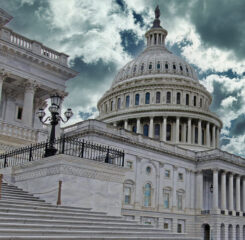Rental Assistance, Eviction Moratorium Extension, and Minimum 4% Housing Credit Floor
The COVID-19 relief package includes important housing-related provisions. The package includes $25 billion in Coronavirus Relief Fund Payments for Rental Assistance and extends the nation eviction moratorium for nonpayment of rent, set to expire on December 31, 2020, until January 31, 2021. The bill also includes a minimum 4% Low Income Housing Tax Credit floor for buildings placed in service after January 20, 2020. None of the bill’s housing-related COVID-19 relief is provided to HUD or HUD programs.
LeadingAge had urged Congress to include in its COVID-19 relief package rental assistance relief, the extension of the eviction moratorium, and the 4% minimum housing credit floor.
The damaging impact of nonpayment of rent for non-HUD assisted owners demanded that any extension of the nationwide eviction moratorium come hand-in-hand with rental assistance for renters and owners.
The economic downturn caused by the coronavirus also quickly weakened the Low Income Housing Tax Credit marketplace. Inclusion in the relief package of a 4% minimum housing credit floor for 4% credits, similar to the 9% floor for 9% credits, will allow needed affordable housing projects to move forward. The street value of the 4% credit fluctuates with the federal borrowing rate; with interest rates low, the actual value of the 4% credit in December 2020 was 3.09%. The fix in the COVID-19 relief bill ensures that the value of the 4% credit will indeed by 4%, saving hundreds of at-risk deals and smoothing the path for future ones. The Housing Credit program did not receive any relief in the March 2020 CARES Act. The 4% credit floor was the top COVID-19 relief ask of the ACTION Campaign, of which LeadingAge is on the steering committee.
The bill does not include any of LeadingAge’s asks to specifically assist HUD multifamily affordable senior housing, nor does it include any relief for USDA Rural Housing Service programs, which have yet to receive any COVID-19 relief whatsoever. Indeed, a long list of housing programs in need of relief, including affordable senior housing, was left out of this slimmed-down relief bill. LeadingAge is ready to immediately begin work on the next COVID-19 relief package.
The $25 billion for rental assistance would be administered by the Department of the Treasury and be distributed to state and local governments based population, with no state receiving less than $200 million.
Renter households with low incomes (i.e., household incomes below 80% of area median income) would be eligible if one or more household member: has qualified for unemployment benefits or has experienced a reduction in household income, incurred significant costs, or experienced other financial hardship due to or during the coronavirus pandemic; and, can demonstrate a risk of experiencing homelessness or housing instability (including having past due utility or rent payment, or an eviction notice; has unsafe or unhealthy living conditions; or has any other evidence of such risk).
Under the $25 billion rental assistance program, landlords and owners may apply on behalf of tenants who meet the eligibility requirements above if the tenant co-signs the rental assistance application, the landlords provides documentation to the tenant of the application, and the payments are used to meet the tenant’s rent obligation to the owners.
Payments from the state or local program must go directly to the housing owner / landlord or to the utility provider on behalf of the eligible household, unless the owner or utility does not agree to accept the funds, in which case the assistance would go to the eligible renter household.
The rental assistance funds can be used for up to 18 months’ of rent, rent arrears, utilities, and other expenses related to housing. Up to 10% of the funds can be used for eviction prevention, rehousing, services referrals, and other housing stability uses.
Rental assistance or other payments provided from these funds would not be treated as household income for purposes of taxation or for determining eligibility for or extent of other benefits or assistance under other federal, state, or local programs.
The bill would also provide $12 billion to Community Development Financial Institutions for targeted community investments to help low income and minority communities withstand the economic impact of the COVID-19 pandemic and respond to this unprecedented economic downturn. These funds include $2 billion in emergency COVID-19 funding to the CDFI Fund for emergency COVID relief and relief to minority communities and $10 billion in emergency capital injections to eligible CDFIs and Minority Depository Institutions to support immediate economic relief in low income and minority communities struggling to respond to the COVID-19 pandemic. Many CDFIs focus their work on affordable housing preservation and development and are key LeadingAge community partners.

Most Recommended
July 11, 2025
 Budget Reconciliation 2025
Budget Reconciliation 2025
July 08, 2025
Pathways for Foreign-Born Workers
Recently Added
July 17, 2025
HUD Posts Updated HOTMA Forms for Public Comment
July 15, 2025



